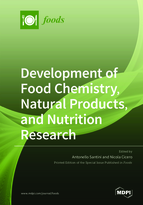Development of Food Chemistry, Natural Products, and Nutrition Research
A special issue of Foods (ISSN 2304-8158). This special issue belongs to the section "Nutraceuticals, Functional Foods, and Novel Foods".
Deadline for manuscript submissions: closed (31 December 2019) | Viewed by 71915
Special Issue Editors
Interests: food chemistry; safety; food safety; nutraceuticals; nanonutraceuticals; recovery from byproducts of the food industry; food contaminants; food supplements; contaminants; risk assessment; mycotoxins and secondary metabolites; chemistry and food education
Special Issues, Collections and Topics in MDPI journals
Interests: food chemistry; food contaminants; fermentation chemistry
Special Issues, Collections and Topics in MDPI journals
Special Issue Information
Dear Colleagues,
Prevention and well-being are closely linked to the wrong lifestyle and dietary habits, which can determine the onset of illness. Some health conditions can be prevented and treated with the proper use of food, natural products, and nutraceuticals in daily diet. A nutraceutical can provide health beneficial effects, e.g., the prevention and/or, in some cases, the treatment of a disease. The key aspect is to define the range of possible uses for these new food–drugs and substantiate them using in vitro and in vivo clinical data that support the efficacy, safety, and possible health benefits. This Special Issue is dedicated to exploit the sources, chemistry, composition, formulation, use, experience in clinical use, mechanisms of action, and clinical data of nutraceuticals, natural products, and food, which represent a new frontier for therapy and also a valuable tool to reduce the costs of health care systems.
Prof. Dr. Antonello Santini
Prof. Dr. Nicola Cicero
Guest Editors
Manuscript Submission Information
Manuscripts should be submitted online at www.mdpi.com by registering and logging in to this website. Once you are registered, click here to go to the submission form. Manuscripts can be submitted until the deadline. All submissions that pass pre-check are peer-reviewed. Accepted papers will be published continuously in the journal (as soon as accepted) and will be listed together on the special issue website. Research articles, review articles as well as short communications are invited. For planned papers, a title and short abstract (about 100 words) can be sent to the Editorial Office for announcement on this website.
Submitted manuscripts should not have been published previously, nor be under consideration for publication elsewhere (except conference proceedings papers). All manuscripts are thoroughly refereed through a single-blind peer-review process. A guide for authors and other relevant information for submission of manuscripts is available on the Instructions for Authors page. Foods is an international peer-reviewed open access semimonthly journal published by MDPI.
Please visit the Instructions for Authors page before submitting a manuscript. The Article Processing Charge (APC) for publication in this open access journal is 2900 CHF (Swiss Francs). Submitted papers should be well formatted and use good English. Authors may use MDPI's English editing service prior to publication or during author revisions.
Keywords
- food
- food contaminants
- health
- nutraceuticals
- prevention
- clinical data
- in vitro data
- therapeutic agents
- clinical experience
- formulation
- natural products
- analytical aspects
- mechanism of action








